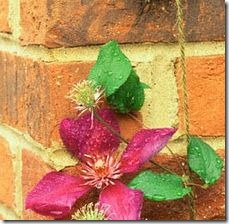Clematis comes in may varieties; most of them yield large beautiful blooms. Clematis can be divided into three groups, depending how and when they need to be pruned: minimal or no pruning clematis, light pruning clematis and hard pruning clematis. This climbing plant needs to be trained according to its pruning method.
- Difficulty:
- Moderately Easy
Instructions
things you’ll need:
- Pruners
- Wiring or string
- Mulch
- Train with minimal or no pruning. Vigorous species clematis that produce their flowers early in the season on stems that have ripened during the previous season should be cut back hard when planted, but then need no routine pruning. Routinely inspect the plant and gently redirect the runners back to the direction you want them to grow. However, if they become too vigorous or grow into a congested, tangled mass, they can be pruned shortly after flowering to keep them in check. Clematis that can be treated in this way include Clematis alpina, C. armandii, C. cirrhosa, C. macropetala and C. montana.
- Train Clematis with light pruning. Clematis cultivars that produce large flowers early in the season on the previous season’s growth should be lightly pruned in very early spring before the plant starts to grow. Clematis in this group include Lasurstern, Marie Boisselot, Mrs. N. Thompson, Nelly Moser, Niobe, The President, and Vyvyan Pennell.
- Remove straggly, diseased, or dying stems when training with light pruning. Cut back the remaining stems by about one third, to just above a healthy pair of green buds; the stems that grow from these buds produce the first flush of blooms in the season.
- Train Clematis with hard pruning. Hard pruning is used on the clematis species and cultivars that produce their flowers late in the season on the current year’s stems. In early spring, before the plant starts to produce new shoots, all the previous season’s growth should be pruned back to just above the lowest pair of strong, healthy buds (about 6 to 12 inches above ground level). Clematis that should be pruned in this way include Comtesse de Bouchaud, Ernest Markham, C. fiorida, Hagley Hybrid, Jackmanii, C. paniculata, Perle d’ Azur, C. tangutica, and Ville de Lyon.
- Cut out any diseased, dead or dying stems when training with a hard pruning. Prune the remainder back to a healthy pair of buds about 6 to 12 inches above ground level. Always cut back to a pair of strong buds with a clean, straight cut. In late spring and summer, tie in the new stems, spacing them out evenly; take care not to break any.
- Use ties to train new growth. As new growth develops it can be tied into the support at regular intervals to train it into the shape you want. Do this carefully since the new stems can be very brittle.
Tips & Warnings
-
Wear gloves and protective eye wear when pruning clematis.


Deprecated: strpos(): Passing null to parameter #1 ($haystack) of type string is deprecated in /home/agriviek8Qv/agriviet.net/public_html/wp-includes/comment-template.php on line 2522